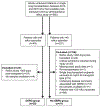Bronchoalveolar bile acid and inflammatory markers to identify high-risk lung transplant recipients with reflux and microaspiration
- PMID: 32487471
- PMCID: PMC7483994
- DOI: 10.1016/j.healun.2020.05.006
Bronchoalveolar bile acid and inflammatory markers to identify high-risk lung transplant recipients with reflux and microaspiration
Abstract
Background: Gastroesophageal reflux disease (GERD) is a risk factor for chronic lung allograft dysfunction. Bile acids-putative markers of gastric microaspiration-and inflammatory proteins in the bronchoalveolar lavage (BAL) have been associated with chronic lung allograft dysfunction, but their relationship with GERD remains unclear. Although GERD is thought to drive chronic microaspiration, the selection of patients for anti-reflux surgery lacks precision. This multicenter study aimed to test the association of BAL bile acids with GERD, lung inflammation, allograft function, and anti-reflux surgery.
Methods: We analyzed BAL obtained during the first post-transplant year from a retrospective cohort of patients with and without GERD, as well as BAL obtained before and after Nissen fundoplication anti-reflux surgery from a separate cohort. Levels of taurocholic acid (TCA), glycocholic acid, and cholic acid were measured using mass spectrometry. Protein markers of inflammation and injury were measured using multiplex assay and enzyme-linked immunosorbent assay.
Results: At 3 months after transplantation, TCA, IL-1β, IL-12p70, and CCL5 were higher in the BAL of patients with GERD than in that of no-GERD controls. Elevated TCA and glycocholic acid were associated with concurrent acute lung allograft dysfunction and inflammatory proteins. The BAL obtained after anti-reflux surgery contained reduced TCA and inflammatory proteins compared with that obtained before anti-reflux surgery.
Conclusions: Targeted monitoring of TCA and selected inflammatory proteins may be useful in lung transplant recipients with suspected reflux and microaspiration to support diagnosis and guide therapy. Patients with elevated biomarker levels may benefit most from anti-reflux surgery to reduce microaspiration and allograft inflammation.
Keywords: bile acid; biomarkers; gastroesophageal reflux disease; inflammation; lung transplantation.
Copyright © 2020 International Society for Heart and Lung Transplantation. Published by Elsevier Inc. All rights reserved.
Conflict of interest statement
DISCLOSURE
The authors of this manuscript have no conflicts of interest to disclose as described by the Journal of Heart and Lung Transplantation.
Figures




References
-
- Yusen RD, Christie JD, Edwards LB, et al. The Registry of the International Society for Heart and Lung Transplantation: Thirtieth Adult Lung and Heart-Lung Transplant Report-2013; focus theme: age. JHeart Lung Transplant. 2013;32(10):965–978. - PubMed
-
- King BJ, Iyer H, Leidi AA, Carby MR. Gastroesophageal reflux in bronchiolitis obliterans syndrome: a new perspective. J Heart Lung Transplant. 2009;28(9):870–875. - PubMed
-
- Young LR, Hadjiliadis D, Davis RD, Palmer SM. Lung transplantation exacerbates gastroesophageal reflux disease. Chest. 2003;124(5):1689–1693. - PubMed
-
- Reder NP, Davis CS, Kovacs EJ, Fisichella PM. The diagnostic value of gastroesophageal reflux disease (GERD) symptoms and detection of pepsin and bile acids in bronchoalveolar lavage fluid and exhaled breath condensate for identifying lung transplantation patients with GERD-induced aspiration. Surg Enclose. 2014;28(6):1794–1800. - PMC - PubMed
-
- Griffin SM, Robertson AGN, Bredenoord AJ, et al. Aspiration and allograft injury secondary to gastroesophageal reflux occur in the immediate post-lung transplantation period (prospective clinical trial). Ann Surg. 2013;258(5):705–711; discussion 711–712. - PubMed
Publication types
MeSH terms
Substances
Grants and funding
LinkOut - more resources
Full Text Sources
Other Literature Sources
Medical

